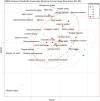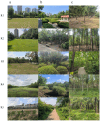Distribution and Influences on Butterfly Diversity in Urban Park Green Spaces: A Case Study of Harbin, China
- PMID: 40519885
- PMCID: PMC12162359
- DOI: 10.1002/ece3.71554
Distribution and Influences on Butterfly Diversity in Urban Park Green Spaces: A Case Study of Harbin, China
Abstract
With the acceleration of urbanization, urban parks play a critical role in protecting biodiversity and maintaining ecosystem stability. As environmental indicator species, butterflies exhibit high sensitivity to environmental changes and anthropogenic disturbances, making them ideal subjects for studying urbanization's impacts on biodiversity. This study focuses on the effects of spatial heterogeneity in the surrounding matrix and its interaction with park resources on butterfly diversity in urban parks. Using Harbin City in Heilongjiang Province, northeastern China, as the study area, we collected data on butterfly species richness and park characteristics from 44 urban parks. Spatial heterogeneity was quantified through landscape metrics across eight spatial scales (100-2500 m), and generalized linear mixed models were employed to analyze butterfly community responses to park characteristics and landscape patterns (composition and configuration) at multiple spatial scales. The results identified 38 butterfly species and 12,885 individuals in Harbin's urban area, with significantly higher species richness in urban fringe zones compared to the city center. Heterogeneity indicators across different spatial scales showed complex relationships with butterfly communities. Butterfly community structure and composition demonstrated highest sensitivity to landscape heterogeneity at 100 and 200 m scales, with optimal model explanatory power for richness, abundance, and diversity being 67.8%, 81.1%, and 38.8% respectively. Key predictors exhibited hierarchical differentiation: richness was primarily positively driven by flowering plant richness and distance from the city center, while being significantly suppressed by park perimeter-area ratio and built-up land patch proportion; abundance was core-driven by flowering plant richness, patch quantity, and patch proximity; diversity relied on the synergistic effects of grassland patch proportion and plant diversity. This study confirms that under intensive urbanization, coordinated management of intra-park habitat resources and surrounding landscape heterogeneity can significantly mitigate urban development-induced butterfly diversity decline, providing a multi-scale planning framework for establishing a "patch-matrix" linkage ecological regulation system in high-latitude cold-region cities.
Keywords: butterfly species richness; landscape matrix; spatial heterogeneity; urban parks; urbanization.
© 2025 The Author(s). Ecology and Evolution published by British Ecological Society and John Wiley & Sons Ltd.
Conflict of interest statement
The authors declare no conflicts of interest.
Figures





Similar articles
-
Impact of urban landscape patterns on butterfly diversity in Fuzhou City parks.Sci Total Environ. 2024 Dec 20;957:177165. doi: 10.1016/j.scitotenv.2024.177165. Epub 2024 Nov 12. Sci Total Environ. 2024. PMID: 39481561
-
Ring roads and urban biodiversity: distribution of butterflies in urban parks in Beijing city and correlations with other indicator species.Sci Rep. 2019 May 21;9(1):7653. doi: 10.1038/s41598-019-43997-8. Sci Rep. 2019. PMID: 31113976 Free PMC article.
-
Can butterflies cope with city life? Butterfly diversity in a young megacity in southern China.Genome. 2016 Sep;59(9):751-61. doi: 10.1139/gen-2015-0192. Epub 2016 Mar 16. Genome. 2016. PMID: 27314400
-
Effects of Landscape Features on Bird Community in Winter Urban Parks.Animals (Basel). 2022 Dec 6;12(23):3442. doi: 10.3390/ani12233442. Animals (Basel). 2022. PMID: 36496963 Free PMC article.
-
Non-linearities in bird responses across urbanization gradients: A meta-analysis.Glob Chang Biol. 2018 Mar;24(3):1046-1054. doi: 10.1111/gcb.13964. Epub 2017 Nov 23. Glob Chang Biol. 2018. PMID: 29080260
References
-
- Alvey, A. A. 2006. “Promoting and Preserving Biodiversity in the Urban Forest.” Urban Forestry & Urban Greening 5, no. 4: 195–201. 10.1016/j.ufug.2006.09.00. - DOI
-
- Ancillotto, L. , Mosconi F., and Labadessa R.. 2024. “A Matter of Connection: The Importance of Habitat Networks for Endangered Butterflies in Anthropogenic Landscapes.” Urban Ecosystems 27, no. 5: 1623–1633. 10.1007/s11252-024-01542-0. - DOI
-
- Archaux, F. , Lorel C., and Villemey A.. 2018. “Landscape Drivers of Butterfly and Burnet Moth Diversity in Lowland Rural Areas.” Landscape Ecology 33: 1725–1739. 10.1007/s10980-018-0697-x. - DOI
LinkOut - more resources
Full Text Sources
Research Materials

